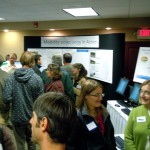Tahoe’s transportation vision outpaces implementation
By Kathryn Reed
If only transportation improvements moved as fast as technology.
No need to use paper or stickers, a computer program can collect the same information more efficiently.
- Analysis
But where was the bus to get people to that technology?
Instead, the parking lot was full. And this, at a meeting about transportation where bike trails were heralded. But, then again, it was snowing by the time the meeting wound down.
This is a reminder that no matter how many bike trails are built or rehabbed, they are not even as seasonal of a resource as a ski resort. After all, those places can be transformed into hiking and biking meccas in their off season. Tahoe bike trails don’t even become cross country or snowshoe trails in their off season.
The Tahoe Metropolitan Planning Organization, an arm of TRPA, rolled out its plan for the future to about 50 people who attended a meeting Nov. 3 at Inn by the Lake in South Lake Tahoe. (No South Lake Tahoe City Council members attended; El Dorado County Supervisor Norma Santiago was a speaker.) About a dozen people attended the North Shore version of the meeting two nights earlier in Kings Beach.
While the Regional Transportation Plan must be updated every four years, the bigger plan is looking out to 2035.
It’s hard to embrace what were called the accomplishments since the last plan was put together in 2008 because most of the ideas had been on the books for longer than four years. Transit shelters that are going in this month; the Highway 50 road-water quality project; lighting for Ski Run/El Dorado Beach; Sawmill, Stateline demo, and Greenway bike projects were touted.
The reality that was not stated by any official is the lighting at El Dorado Beach/Lakeview Commons is not what South Lake Tahoe wanted because TRPA said no to overhead lighting. Phase two of Sawmill is a year behind. While the Greenway project is in the permitting phase, there is no money to bring it to fruition.
Much like all the placed based planning sessions for the TRPA Regional Plan that were started in 2005, this had a similar feel. Instead of having to put stickers on white pieces of paper, people could use CrowdBrite to do it electronically. People not at the meeting may log in to CrowdBrite for the next 30 days to contribute ideas. Access is also via the TMPO website.
One of the interactive components allowed computer users to spend $650 million on South Shore projects and another $475 million on North Shore. The categories to choose from included stormwater, bike-pedestrian, road revitalization, transit, and managing transportation demand.
It showed maintenance of existing and future bike paths on the South Shore with a $6 million price tag.
Those million dollar figures are what the TMPO expects to have to spend through 2035. The sources are evenly split between local, state and federal entities. It was not explained any further where the money specifically comes from.
The same ideas that have been written or mouthed for eons came spewing forward – have a free bus system, create a class 1 bike trail from Meyers to the Y, clear the bike paths in the winter.
Part of the big picture is contending with California mandated green house emission reductions. By 2020 the amount of emissions is supposed to drop by 7 percent per person and another 5 percent by 2035.
Karen Fink, TMPO transportation planner, said this is the equivalent of everyone not driving one day per month.
A project list will be created based on public input. The draft plan should be out for review in March, with the final plan ready in August 2012.
Staff is working on the premise of complete streets being the No. 1 policy goal. The three programs it is likely to pursue are: reducing employee trips via shuttles or flexible scheduling, real time traveler information via electronic signs, and parking management where entities may share asphalt. Projects will be ones that can be funded in a reasonable future.
How all this public input being collected will be incorporated remains to be seen.
More information is on the Tahoe Metropolitan Planning Organization’s website.
